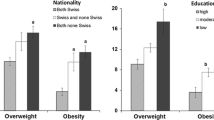Abstract
From their school health files, the body mass index of 2607 children, 1268 boys and 1339 girls, from the Brussels region of Belgium was analysed. The aim was to study the relationship between obesity and social class, gender and nationality. In Belgian girls, the lower their social class, the higher was the prevalence and severity of obesity. There was no such significant relationship in Belgian boys, nor in immigrant children of either sex, although the overall prevalence of obesity was similar in all groups. These results question certain hypotheses proposed to explain the relationship between social class and obesity.
Conclusion
From early adolescence on, social inequality influences the prevalence of obesity in Belgian girls, but not in Belgian boys nor in immigrant children. Prevention of obesity should take into account the influence of gender, social class and ethnic origin.
Similar content being viewed by others
Abbreviations
- BMI:
-
body mass index
References
Braddon EMF, Rogers B, Wadsworth M, Davies JMC (1986) Onset of obesity in a 36-year birth cohort study. BMJ 293:299–303
Cole TJ, Freeman JV, Preece MA (1995) Body mass index reference curves for the UK, 1990. Arch Dis Child 73:25–29
Dean AG, Dean JA, Coulombier D, Brendel KA, Smith DC, Burton AH, et al (1994) Epi Info, Version 6: a word processing, database, and statistics program for epidemiology on microcomputers. Centers for Disease Control and Prevention, Atlanta, Georgia, U.S.A.
De Onis M, Habicht JP (1996) Anthropométric reference data for international use: recommandations from a World Health Organization Expert Committee. Am J Clin Nutr 64: 650–658
Edlund B, Hallqvist G, Sjoden PO (1994) Attitudes to food, eating and dieting behaviour in 11- and 14-year-old Swedish children. Acta Paediatr 83:572–577
Epstein LH, Valoski I, Wing PR (1985) Childhood obesity. Pediatr Clin North Am 32:363–379
Flegal KM, Harlan WR, Landis JR (1988) Secular trends in body mass index and skinfold thickness with socioeconomic factors in young adult men. Am J Clin Nutr 48:544–551
Garn SM, Leonard WR, Hawthorne VM (1986) Three limitations of the body mass index. Am J Clin Nutr 44: 996–997
Gortmaker SL, Dietz WH, Sobol AM, Wehler CA (1987) Increasing pediatric obesity in the United States. Am J Dis Child 141:535–540
Gortmaker SL, Must A, Perrin JM, Sobol AM, Dietz WH (1993) Social and economic consequences of overweight in adolescence and young adulthood. N Engl J Med 329:1008–1012
Greenland S, Robins JM (1985) Estimation of a common effect parameter from sparse follow-up data. Biometrics 41:55–68
Hammer LD, Kraemer HC, Wilson DM, Ritter PL, Dornbush SM (1991) Standardized percentile curves of body mass index for children and adolescents. Am J Dis Child 145: 259–263
Himes JH, Dietz WH (1994) Guidelines for overweight in adolescent preventive services: recommandations from an expert committee. Am J Clin Nutr 59: 307–316
Jeffery RW, Forster JL, Folsom AR, Luepker RV, Jacobs DR, Blackburn H (1989) The relationship between social class and body mass index in the Minnesota Heart Health Program. Int J Obesity 13:59–67
Jeffery RW, French SA, Forster JL, Spry VM (1991) Socio-economic status differences in health behaviors related to obesity: the Healthy Worker Project. Int J Obesity 15:689–696
Laurier D, Guiguet M, Nguyen Phong Chau, Welles JA, Valleron AJ (1992) Prevalence of obesity: a comparative survey in France, the United Kingdom and the United States. Int J Obesity 16:565–572
Lazarus R, Baur L, Webb, Blyth F (1996) Body mass index in screening for adiposity in children and adolescents: systematic evaluation using receiver operating characteristic curves. Am J Clin Nutr 63: 500–506
Lindgren G, Strandell A, Cole T, Healy M, Tanner J (1995) Swedish population reference standards for height, weight and body mass index attained at 6 to 16 years (girls) or 19 years (boys). Acta Paediatr 84:1019–1028
Melnyk MG, Weinstein E (1994) Preventing obesity in black women by targeting adolescents: a literature review. J Am Diet Assoc 94(5):536–540
Must A, Jacques PF, Dallai GE, Bajema CJ, Dietz WH (1992) Long term morbidity and mortality of overweight adolescents. N Engl J Med 327:1350–1355
Peckham CS, Stark O, Simonite V, Wolff OH (1983) Prevalence of obesity in British children born in 1946 and 1958. BMJ 286:1237–1242
Poskitt EME (1995) Defining childhood obesity: the relative body mass index (BMI). Acta Paediatr 84:961–963
Power C, Moynihan C (1988) Social class and changes in weight-for-height between childhood and early adulthood. Int J Obesity 12:445–453
Rolland-Cachera MF, Bellisle F (1986) No correlationship between adiposity and food intake: why are working class children fatter? Am J Clin Nutr 44:779–787
Rolland-Cachera MF, Cole TJ, Sempé M, Tichet J Rossignol C, Charraud A (1991) Body Mass Index variations: centiles from birth to 87 years. Eur J Clin Nutr 45:13–21
Seidman DS, Laor A, Gale R, Stevenson DK, Danon YL (1991) A longitudinal study of birth weight and being overweight in late adolescence. Am J Dis Child 145:782–785
Sobal J, Stunkard AJ (1990) Socioeconomic status and obesity: a review of the literature. Psych Bul 105:260–275
Sonne-Holm S, Sorensen TIA (1986) Prospective study of attainment of social class of severely obese subjects in relationship to parental social class, intelligence and education. BMJ 292:586–589
Stark O, Atkins Z, Wolff OH, Douglas JBW (1981) Longitudinal study of obesity in the National Survey of Health and Development. BMJ 283:13–17
White EM, Wilson AC, Green SA, Mc Cowan C, Thomas GE, Cairns AY, Ricketts IW (1995) Body mass index centile charts to assess fatness of British children. Arch Dis Child 72:38–41
Author information
Authors and Affiliations
Rights and permissions
About this article
Cite this article
De Spiegelaere, M., Hennart, P. & Dramaix, M. Social class and obesity in 12-year-old children in Brussels: Influence of gender and ethnic origin. Eur J Pediatr 157, 432–435 (1998). https://doi.org/10.1007/s004310050845
Received:
Revised:
Accepted:
Issue Date:
DOI: https://doi.org/10.1007/s004310050845



